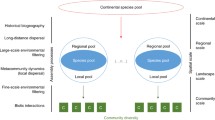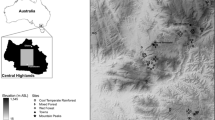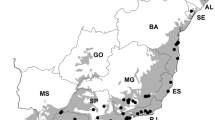Abstract
Species richness is influenced by a nested set of environmental factors, but how do these factors interact across several scales? Our main aim is to disentangle the relative importance of environmental filters and the species pool on the richness of epiphytic bryophytes across spatial scales. To do so, we sampled epiphytic bryophytes in 43 oak forests across the northwest of the Iberian Peninsula. As predictors we used climate, descriptors of forest structure and micro-environment. We applied structural equation modeling to relate these variables with richness and cover at three scales: locality (forest), stand (three stands per forest), and sample (a quadrate in a tree). We assumed top–down relationships, so that large-scale variables influenced lower scale variables, and in which cover directly influenced richness. Richness at the next larger scale (locality to stand and stand to sample) is considered a surrogate of the species pool and included as a predictor of richness at the next smaller scale. Environmental variables explain locality richness, but as we decrease the spatial scale, its importance decreases and the dependence on species pool increases. In addition, we found unexpected bottom–up relationships (between micro-scale environment to locality richness). Our results point to the scale dependence of niche vs. neutral processes: niche processes are important at the locality (forest) scale, while neutral processes are significant at the small (sample) scale. We propose a modified conceptualization of the factors influencing biodiversity at different spatial scales by adding links across different scales (between micro-environment and locality-scale richness in our study).




Similar content being viewed by others
References
Albertos B (2001) Estudio biogeográfico de los briófitos epífitos del noroccidente peninsular. PhD dissertation, Department of Biology, Autonomous University of Madrid, Madrid, Spain
Aranda SC, Gabriel R, Borges PAV, Santos AMC, Hortal J, Baselga A, Lobo JM (2013) How do different dispersal modes shape the species–area relationship? Evidence for between-group coherence in the Macaronesian flora. Glob Ecol Biogeogr 22:483–493. https://doi.org/10.1111/geb.12008
Arellano G, Cayola L, Loza I, Torrez V, Macía MJ (2014) Commonness patterns and the size of the species pool along a tropical elevational gradient: insights using a new quantitative tool. Ecography 37:536–543. https://doi.org/10.1111/j.1600-0587.2013.00546.x
Bacaro G, Rocchini D, Bonini I, Marignani M, Maccherini S, Chiarucci A (2008) The role of regional and local scale predictors for plant species richness in Mediterranean forests. Plant Biosyst 142:630–642
Barkman JJ (1958) On the ecology of cryptogamic epiphytes. Van Gorcum, The Netherlands
Callaghan DA, Ashton PA (2008) Knowledge gaps in bryophyte distribution and prediction of species-richness. J Bryol 30:147–158. https://doi.org/10.1179/174328208x282445
Cornell HV, Harrison SP (2013) Regional effects as important determinants of local diversity in both marine and terrestrial systems. Oikos 122:288–297. https://doi.org/10.1111/j.1600-0706.2012.20691.x
Cornell HV, Lawton JH (1992) Species interactions, local and regional processes, and limits to the richness of ecological communities: a theoretical perspective. J Anim Ecol 61:1–12. https://doi.org/10.2307/5503
de Bello F, Fibich P, Zelený D, Kopecký M, Mudrák O, Chytrý M, Pyšek P, Wild J, Michalcová D, Sádlo J, Šmilauer P, Lepš J, Pärtel M (2016) Measuring size and composition of species pools: a comparison of dark diversity estimates. Ecol Evol 6:4088–4101. https://doi.org/10.1002/ece3.2169
de Oliveira SM, Ter Steege H, Cornelissen JHC, Robbert Gradstein S (2009) Niche assembly of epiphytic bryophyte communities in the Guianas: a regional approach. J Biogeogr 36:2076–2084. https://doi.org/10.1111/j.1365-2699.2009.02144.x
Draper I, Lara F, Albertos B, Garilleti R, Mazimpaka V (2003) The epiphytic bryoflora of the Jbel Bouhalla (Rif, Morocco), including a new variety of moss, Orthotrichum speciosum var. brevisetum. J Bryol 25:271–280. https://doi.org/10.1179/037366803225013146
Draper I, Mazimpaka V, Albertos B, Garilleti R, Lara F (2005) A survey of the epiphytic bryophyte flora of the Rif and Tazzeka mountains (northern Morocco). J Bryol 27:23–34
During HJ, Lloret F (2001) The species-pool hypothesis from a bryological perspective. Folia Geobot 36:63–70
Elton C (1946) Competition and the structure of ecological communities. J Anim Ecol 15:54–68. https://doi.org/10.2307/1625
Eriksson O (1993) The species-pool hypothesis and plant community diversity. Oikos 68:371–374. https://doi.org/10.2307/3544854
Ewald J, Økland RH (2002) A probabilistic approach to estimating species pools from large compositional matrices. J Veg Sci 13:191–198. https://doi.org/10.1658/1100-9233(2002)013[0191:apates]2.0.co;2
Flores-Palacios A, García-Franco JG (2006) The relationship between tree size and epiphyte species richness: testing four different hypotheses. J Biogeogr 33:323–330
Gignac LD, Dale MRT (2005) Effects of fragment size and habitat heterogeneity on cryptogam diversity in the low-boreal forest of western Canada. Bryologist 108:50–66. https://doi.org/10.1639/0007-2745(2005)108[50:eofsah]2.0.co;2
González-Mancebo JM, Losada-Lima A, Llorente JP (2004) Forest floor bryophytes of laurel forest in Gomera (Canary Islands): life strategies and influence of the tree species. Lindbergia 29:5–16
Grace J (2006) Structural equation modeling and natural systems. Cambridge University Press, New York
Grace JB, Michael Anderson T, Smith MD, Seabloom E, Andelman SJ, Meche G, Weiher E, Allain LK, Jutila H, Sankaran M, Knops J, Ritchie M, Willig MR (2007) Does species diversity limit productivity in natural grassland communities? Ecol Lett 10:680–689. https://doi.org/10.1111/j.1461-0248.2007.01058.x
Gravel D, Canham CD, Beaudet M, Messier C (2006) Reconciling niche and neutrality: the continuum hypothesis. Ecol Lett 9:399–409. https://doi.org/10.1111/j.1461-0248.2006.00884.x
Grime JP (1973) Competitive exclusion in herbaceous vegetation. Nature 242:344–347. https://doi.org/10.1038/242344a0
Guisan A, Rahbek C (2011) SESAM—a new framework integrating macroecological and species distribution models for predicting spatio-temporal patterns of species assemblages. J Biogeogr 38:1433–1444. https://doi.org/10.1111/j.1365-2699.2011.02550.x
Hijmans RJ, Cameron SE, Parra JL (2006) WorldClim Global Climate Layers Version 1.4. Available at https://www.worldclim.org
Harrison S, Cornell H (2008) Toward a better understanding of the regional causes of local community richness. Ecol Lett 11:969–979
Harrison S, Safford HD, Grace JB, Viers JH, Davies KF (2006) Regional and local species richness in an insular environment: serpentine plants in California. Ecol Monogr 76:41–56. https://doi.org/10.1890/05-0910
He F, Gaston KJ, Connor EF, Srivastava DS (2005) The local-regional relationship: inmigration, extintion, and scale. Ecology 86:360–365. https://doi.org/10.1890/04-1449
Hespanhol H, Séneca A, Figueira R, Sérgio C (2011) Microhabitat effects on bryophyte species richness and community distribution on exposed rock outcrops in Portugal. Plant Ecol Divers 4:251–264. https://doi.org/10.1080/17550874.2011.616546
Hortal J, Roura-Pascual N, Sanders NJ, Rahbek C (2010) Understanding (insect) species distributions across spatial scales. Ecography 33:51–53. https://doi.org/10.1111/j.1600-0587.2009.06428.x
Hubbell SP (2001) The unified neutral theory of biodiversity and biogeography. Princeton University Press, New Jersey
Humphrey J, Davey S, Peace A, Ferris R, Harding K (2002) Lichens and bryophyte communities of planted and semi-natural forests in Britain: the influence of site type, stand structure and deadwood. Biol Cons 107:165–180. https://doi.org/10.1016/s0006-3207(02)00057-5
Ingerpuu N, Vellak K, Liira J, Pärtel M (2003) Relationships between species richness patterns in deciduous forests at the north Estonian limestone escarpment. J Veg Sci 14:773–780. https://doi.org/10.1658/1100-9233(2003)014[0773:rbsrpi]2.0.co;2
Karst J, Gilbert B, Lechowicz MJ (2005) Fern community assembly: the roles of chance and the environment at local and intermediate scales. Ecology 86:2473–2486. https://doi.org/10.1890/04-1420
Keddy PA (1992) Assembly and response rules: two goals for predictive community ecology. J Veg Sci 3:157–164. https://doi.org/10.2307/3235676
Király I, Nascimbene J, Tinya F, Ódor P (2013) Factors influencing epiphytic bryophyte and lichen species richness at different spatial scales in managed temperate forests. Biodivers Conserv 22:209–223. https://doi.org/10.1007/s10531-012-0415-y
Klanderud K (2010) Species recruitment in alpine plant communities: the role of species interactions and productivity. J Ecol 98:1128–1133. https://doi.org/10.1111/j.1365-2745.2010.01703.x
Lara F (1993) Estudio biogeográfico de los briófitos epífitos de los melojares del Sistema Central Oriental (Sierras de Gredos, Guadarrama y Ayllón). PhD dissertation, Department of Biology, Autonomous University of Madrid, Madrid, Spain
Lara F, Mazimpaka V (1998) Succession of epiphytic bryophytes in a Quercus pyrenaica forest from the Spanish Central Range (Iberian Peninsula). Nova Hedwigia 67:125–138
Lawton JH (1999) Are there general laws in ecology? Oikos 84:177. https://doi.org/10.2307/3546712
Legendre P, Mi X, Ren H, Ma K, Yu M, Sun I-F, He F (2009) Partitioning beta diversity in a subtropical broad-leaved forest of China. Ecology 90:663–674. https://doi.org/10.1890/07-1880.1
Löbel S, Rydin H (2009) Dispersal and life history strategies in epiphyte metacommunities: alternative solutions to survival in patchy, dynamic landscapes. Oecologia 161:569–579
Löbel S, Dengler J, Hobohm C (2006) Species richness of vascular plants, bryophytes and lichens in dry grasslands: The effects of environment, landscape structure and competition. Folia Geobotanica 41(4):377–393
Lortie CJ, Brooker RW, Choler P, Kikvidze Z, Michalet R, Pugnaire FI, Callaway RM (2004) Rethinking plant community theory. Oikos 107:433–438. https://doi.org/10.1111/j.0030-1299.2004.13250.x
Mazimpaka V, Lara F (1995) Corticolous bryophytes on Quercus pyrenaica forests from Gredos Mountains (spain): vertical distribution and affinity for epiphytic habitats. Nova Hedwigia 61:431–446
Mazimpaka V, Medina NG, Lo Giudice R, Garilleti R, Lara F (2010) Tree age-dependent changes among epiphytic bryophyte communities in Mediterranean environments. a case study from Sicily (Italy). Plant Biosyst 144:241–249. https://doi.org/10.1080/11263500903561080
Medina NG, Lara F, Mazimpaka V, Hortal J (2013) Designing bryophyte surveys for an optimal coverage of diversity gradients. Biodivers Conserv 22:3121–3139. https://doi.org/10.1007/s10531-013-0574-5
Medina NG, Albertos B, Lara F, Mazimpaka V, Garilleti R, Draper D, Hortal J (2014) Species richness of epiphytic bryophytes: drivers across scales on the edge of the Mediterranean. Ecography 37:80–93. https://doi.org/10.1111/j.1600-0587.2013.00095.x
Medina NG, Lara F, Mazimpaka V, Albertos B, Alonso I, Hortal J (2015) Epiphytic bryophytes of forests in Central and North inland Iberian Peninsula. Front Biogeogr 7:1–8
Münzbergová Z, Herben T (2004) Identification of suitable unoccupied habitats in metapopulation studies using co-occurrence of species. Oikos 105:408–414. https://doi.org/10.1111/j.0030-1299.2004.13017.x
Pärtel M, Zobel M, Zobel K, van der Maarel E (1996) The species pool and its relation to species richness: evidence from Estonian plant communities. Oikos 75:111–117. https://doi.org/10.2307/3546327
Pärtel M, Szava-Kovats R, Zobel M (2011) Dark diversity: shedding light on absent species. Trends Ecol Evol 26:124–128. https://doi.org/10.1016/j.tree.2010.12.004
Pharo EJ, Kirkpatrick JB, Gilfedder L, Mendel L, Turner PAM (2005) Predicting bryophyte diversity in grassland and eucalypt-dominated remnants in subhumid Tasmania. J Biogeogr 32:2015–2024. https://doi.org/10.1111/j.1365-2699.2005.01366.x
Raabe S, Mueller J, Manthey M, Duerhammer O, Teuber U, Goettlein A, Foerster B, Brandl R, Baessler C (2010) Drivers of bryophyte diversity allow implications for forest management with a focus on climate change. For Ecol Manage 260:1956–1964. https://doi.org/10.1016/j.foreco.2010.08.042
Rajaniemi TK (2003) Explaining productivity-diversity relationships in plants. Oikos 101:449–457
Rambo TR (2001) Decaying logs and habitat heterogeneity: implications for bryophyte diversity in Western Oregon forests. Northwest Sci 75:270–277
Ricklefs RE (1987) Community diversity: relative roles of local and regional processes. Science 235:167–171
Ros RM, Mazimpaka V, Abou-Salama U, Aleffi M, Blockeel TL, Brugués M, Cano MJ, Cros RM, Dia MG, Dirkse GM, El-Saadawi W, Erdağ A, Ganeva A, Gonzalez-Mancebo JM, Herrnstadt I, Khalil K, Kurschner H, Lanfranco E, Losada-Lima A, Refai MS, Rodriguez-Nuñez S, Sabovljević M, Sergio C, Shabbara HM, Sim-Sim M, Soderström L (2007) Hepatics and Anthocerotes of the Mediterranean, an annotated checklist. Cryptogam Bryol 28:351–437
Ros RM, Mazimpaka V, Abou-Salama U et al (2013) Mosses of the Mediterranean, an Annotated Checklist. Cryptogam Bryol 34:99–283. https://doi.org/10.7872/cryb.v34.iss2.2013.99
Rydin H, Barber KE (2001) Long-term and fine-scale coexistence of closely related species. Folia Geobot 36:53–61. https://doi.org/10.1007/bf02803138
Shipley B (2000) A new inferential test for path models based on directed acyclic graphs. Struct Equ Model Multidiscip J 7:206–218. https://doi.org/10.1207/s15328007sem0702_4
Shipley B (2009) Confirmatory path analysis in a generalized multilevel context. Ecology 90:363–368. https://doi.org/10.1890/08-1034.1
Srivastava DS (1999) Using local–regional richness plots to test for species saturation: pitfalls and potentials. J Anim Ecol 68:1–16
Stein A, Gerstner K, Kreft H (2014) Environmental heterogeneity as a universal driver of species richness across taxa, biomes and spatial scales. Ecol Lett 17:866–880. https://doi.org/10.1111/ele.12277
Sydenham MAK, Moe SR, Totland Ø, Eldegard K (2015) Does multi-level environmental filtering determine the functional and phylogenetic composition of wild bee species assemblages? Ecography 38:140–153. https://doi.org/10.1111/ecog.00938
Szava-Kovats RC, Ronk A, Pärtel M (2013) Pattern without bias: local–regional richness relationship revisited. Ecology 94:1986–1992. https://doi.org/10.1890/13-0244.1
Vitt DH, Li Y, Belland RJ (1995) Patterns of bryophyte diversity in peatlands of continental western Canada. Bryologist 98:218–227
Whittaker RJ, Willis KJ, Field R (2001) Scale and species richness: towards a general, hierarchical theory of species diversity. J Biogeogr 28:453–470. https://doi.org/10.1046/j.1365-2699.2001.00563.x
Zechmeister HG, Tribsch A, Moser D, Peterseil J, Wrbka T (2003) Biodiversity ‘hot spots’ for bryophytes in landscapes dominated by agriculture in Austria. Agr Ecosyst Environ 94:159–167. https://doi.org/10.1016/s0167-8809(02)00028-2
Zobel M (1997) The relative of species pools in determining plant species richness: an alternative explanation of species coexistence? Trends Ecol Evol 12:266–269. https://doi.org/10.1016/s0169-5347(97)01096-3
Zobel K (2001) On the species-pool hypothesis and on the quasi-neutral concept of plant community diversity. Folia Geobotanica 36:3–8
Acknowledgements
This research has been funded by the Spanish Ministry of Science and Innovation (Grants CGL2007-61389, CGL2010-15693 and CGL2011-28857). JH is supported by a Spanish Dirección General de Ciencia y Tecnología (DGCyT) Ramón y Cajal Grant. NGM is supported by the Grant AP2007-00905 of the Spanish Ministry of Science. We would like to thank two anonymous referees for their thorough review and constructive comments.
Author information
Authors and Affiliations
Contributions
NGM, FL, JH, and VM originally formulated the idea; NGM and VM conducted fieldwork; NGM and MAB analyzed the data; NGM lead the writing process; FL, JH, MAB, and VM actively contributed to discuss the results and write the manuscript.
Corresponding author
Additional information
Communicated by John Dwyer.
Electronic supplementary material
Below is the link to the electronic supplementary material.
Rights and permissions
About this article
Cite this article
Medina, N.G., Bowker, M.A., Hortal, J. et al. Shifts in the importance of the species pool and environmental controls of epiphytic bryophyte richness across multiple scales. Oecologia 186, 805–816 (2018). https://doi.org/10.1007/s00442-018-4066-x
Received:
Accepted:
Published:
Issue Date:
DOI: https://doi.org/10.1007/s00442-018-4066-x




